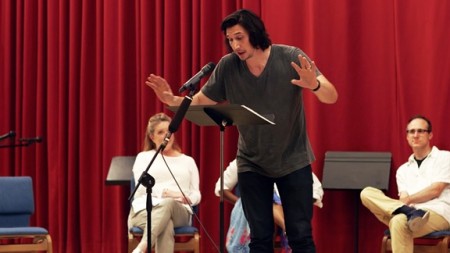
December of 2015 Vice News (a rapidly emerging online media outlet for the “connected generation”) premiered an intriguing documentary entitled, “Adam Driver Brings Monologues to the Military: Arts in the Armed Forces”.
Led by Marine-turned-actor Adam Driver (Girls, Star Wars: The Force Awakens), and his wife AITAF’s Artistic Director Joanne Tucker, we follow can’t-quite-place their faces thespians, as they travel across America and the Middle East performing monologues on military stages. The non-profit initiative (founded by Driver while studying at Julliard) is meant to be therapeutically inspiring, provoke conversation and above all entertain servicemen-women of the branched armed forces through exposure to contemporary theatre.
“We’re hoping to show that language is a powerful tool, that self-expression is a powerful tool — it’s just as valuable as any rifle you carry or any tool you can put in your pack.” – Driver
The grass roots reasoning behind the program is quite simple. Referring to past entertainment for active military (i.e. visiting celebrities and cheerleaders) Driver articulates, “I remember those events that we had that were all well-intended and great, but seemed a little dumbed-down considering what we were there to do.” The half hour documentary excels in showing perspectives of both the entertainers and the entertained, while not shying away from the reality of organizing the traveling enterprise. We see how the progressive idea of the program is met with immediate resistance. From stage production elements malfunctioning, extreme desert heat, and lack of understanding from schedulers and senior officers, it becomes clear Driver and Co. are hitting a nerve with storied military tradition. A “why fix it-if it ain’t broke” mentality is evident at the first few locations of their tour.
However, for those who do attend, the free performances are a welcome pause from the everyday pressures of military life. Very quickly, it becomes clear that the program is something special – via audience reaction. Close-ups of smiles, gasps or any elicited response from an audience member can be tallied as a success for the initiative. It’s about connection. After each performance, the audience is invited to converse with the actors and the direct impact just experienced is clear. Conversations are short with gratitude being expressed from all parties for each other’s contribution to society. These featured moments are the most impactful in the documentary.
“You can’t place a value on the arts…just planting that seed of a character we can all relate too may have benefits down the road” – Driver
Avant-garde aside, AITAF is undoubtedly bridging a commentary on the positive effects art provides for active military and veterans. While the war being fought abroad is evident, what happens at home is another story – a strong undertone of the piece.
A recent study, the largest ever, by the U.S. government RAND Corporation states that the U.S. military is struggling to provide adequate therapy for thousands of active-duty troops and veterans. Out of 40,000 cases, only a third of troops with PTSD and less than a quarter who are clinically depressed receive the minimum number of therapy sessions after diagnosis. Maj. Gary H. Wynn, a research psychiatrist at Walter Reed Army Institute of Research, states, “Fewer than half of the soldiers who report symptoms of combat-related PTSD receive the care they need, and of those soldiers who do start treatment, between 20 percent and 50 percent walk away before its completion.”
These examples display a correlated cause and effect of government treatment vs. soldier interest. The effects of PTSD vary dramatically from person to person and a one size fits all solution is clearly not the answer. While traditional therapy and prescription medications exist, complementary treatments, such as art therapy, are quickly growing as creative means of learning how to cope at home. Josée Leclerc, a professor in the Department of Creative Arts Therapies, says, “Art therapy can engage the creative potential of individuals — especially those suffering from PTSD. Art therapy is considered a mind-body intervention that can influence physiological and psychological symptoms. The experience of expressing oneself creatively can reawaken positive emotions and address symptoms of emotional numbing in individuals with PTSD.”
“I was getting exposed to characters and playwrights and plays who had nothing to do with the military that were articulating my military experience better than I was able to at the time” -Driver
In Driver’s case, as we learn, his transition from military to civilian life was not seamless. Through the performing arts a voice and passion was awakened in him. The hope is that the same can occur for anyone suffering from a mental disorder or stress from service pressures is the conclusion of the documentary. As the future direction of the military and funding for the Veteran’s Administration is vehemently debated during the caucuses, Monologues to the Military: Arts in the Armed Forces is not about solving problems, but providing a perspective on solutions to them.
4/4
(Documentary link for viewing)
–Steven Havira: Artist, Actor, Writer/Producer